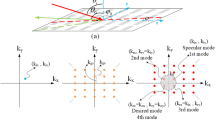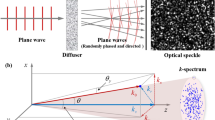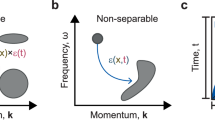Abstract
EXPERIMENTAL and theoretical data on the reflexion of light from shock waves have given conflicting results. Hornig et al.1–3 have proposed that, because the shock front separates two regions of different density, Fresnel-type reflexions should occur. Further, they have demonstrated that such reflexions can be observed from shock fronts propagating in dry atmospheres in shock tubes. Mallory4 has observed a reflexion of a ruby laser beam from the vicinity of a shock front produced by an explosive detonation in air. He found the intensity of the reflected light was three or four orders of magnitude greater than that which could be explained on the basis of a Fresnel reflexion. It seemed that a different phenomenon was giving rise to such reflexions.
This is a preview of subscription content, access via your institution
Access options
Subscribe to this journal
Receive 51 print issues and online access
$199.00 per year
only $3.90 per issue
Buy this article
- Purchase on SpringerLink
- Instant access to full article PDF
Prices may be subject to local taxes which are calculated during checkout
Similar content being viewed by others
References
Cowan, G. R., and Hornig, D. F., J. Chem. Phys., 17, 1008 (1950).
Green, E. F., Cowan, G. R., and Hornig, D. F., J. Chem. Phys., 19, 427 (1951).
Linzer, M., and Hornig, D. F., Physics of Fluids, 6, 1661 (1963).
Mallory, W. R., Nature, 209, 175 (1966).
United States Department of Defense, The Effects of Nuclear Weapons, edit. by Glasstone, S., 47 (U.S. Atomic Energy Commission, 1962).
Munick, R. J., J. Opt. Soc. Amer., 55, 893 (1965).
Author information
Authors and Affiliations
Rights and permissions
About this article
Cite this article
COURT, I., MALLORY, W. Anomalous Reflectivity of Shock Waves. Nature 211, 625 (1966). https://doi.org/10.1038/211625a0
Issue date:
DOI: https://doi.org/10.1038/211625a0



